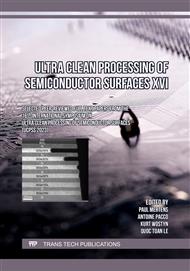[1]
Information on https://spectrum.ieee.org/fabs-cut-back-water-use.
Google Scholar
[2]
Submitted to Water & Energy Management subchapter in International Roadmap for Devices and Systems 2023 Update.
Google Scholar
[3]
M. Meuris, P.W. Mertens, A. Opdebeeck, H.F. Schmidt, M. Depas, G. Vereecke, M.M. Heyns, and A. Philipossian, "The IMEC clean: A new concept for particle and metal removal on Si surfaces," Solid State Technology July 1995, 109-113.
Google Scholar
[4]
H. Morita, T. Ii, J. Ida and T. Ohmi, "Total Room Temperature Wet Cleaning Process Based on Specific Gases Dissolved Ultrapure Water," Electrochemical Society Proceedings 99-36, 45-50 (1999).
DOI: 10.1109/issm.1999.808834
Google Scholar
[5]
I. Kashkoush and R. Novak, "Optimization of Deionized Water Consumption in Wafer Wet Processing," Solid State Phenomena 65-66, 49-52 (1999).
DOI: 10.4028/www.scientific.net/ssp.65-66.49
Google Scholar
[6]
F. Tardif, F. de Bourmont, T. Vareine, V. Oravec and A. DiMartino, "A Novel Rinsing Tank Concept to Save DI Water Using an Internal Recirculation Flow: 'Circle Stream Rinser'," Solid State Phenomena 76-77, 191-194 (2001).
DOI: 10.4028/www.scientific.net/ssp.76-77.191
Google Scholar
[7]
K. Sano, A. Izumi, A. Eitoku, J. Snow, L. Nyns, S. Kubicek, R. Singanamalla, O. Richard, T. Conard, R. Vos and P.W. Mertens, "Single-Wafer Wet Chemical Oxide Formation for Pre-ALD High-k Deposition on 300 mm Wafer," Solid State Phenomena 134, 53-56 (2008).
DOI: 10.4028/www.scientific.net/ssp.134.53
Google Scholar
[8]
D. Maloney, "Review of Gases & Chemicals by Process Module," Business of Cleans 2022, October 19, 2022, Phoenix.
Google Scholar
[9]
J. Snow, H. Masayuki, S. Nobuyuki and E. Toru, "Towards Sustainable Fab: Reducing Bulk Chemicals by SPM Reuse in Single-Wafer Process Applications," SEMICON Europa Tech Arena, November 17, 2022, Munich.
Google Scholar
[10]
Y. Okuno, "Sustainability Driven Innovation: transistor scaling and defectivity targets for sustainable manufacturing," SEMICON Europa Tech Arena, November 17, 2022, Munich.
Google Scholar
[11]
P. Kerr and R. Tanaka: submitted for presentation to Ultrapure Micro Conference 2023, October 10-12, 2023, Austin.
Google Scholar
[12]
C. Miller, H. Masayuki, S. Nobuyuki, and E. Toru, "Recycling of SPM in Single-Wafer Process Applications," Ultrapure Micro 2022, September 28-30, 2022, Phoenix.
Google Scholar


